Tree Watch
Lawsons Cypress - Chamaecyparis lawsoniana
The tree is named after the Edinburgh nurseryman and plant collector Charles Lawson who brought seeds back to Britain from California in 1854.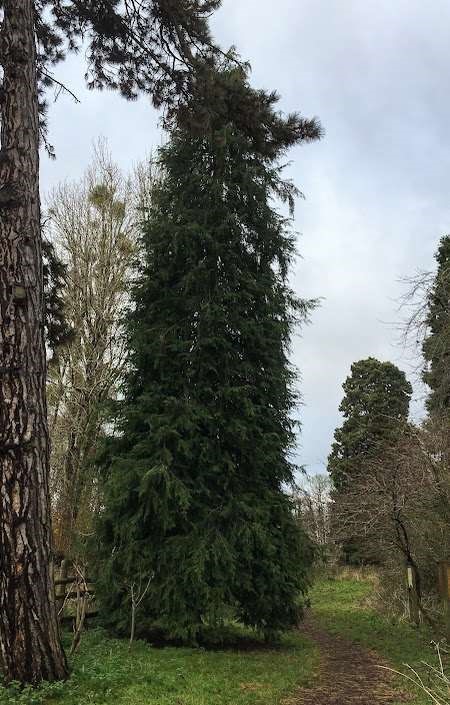
It is a tall evergreen conifer, up to 45 metres in height, with a conical shape. Its trunk often forks and the bark has clear vertical cracks. It has many, short, individual leaves like scales, making up flat shoots which resemble miniature ferns. They are paler on the underside and smell rather like parsley when crushed. Flowers, which appear on the tips of twigs in spring, start pinky red and become yellow with pollen. The ensuing round cones start green, ripen to brown and are pea sized.
Lawsons Cypress has the peculiarity of throwing out ‘sports’, ie a branch that is different from the rest of the plant. 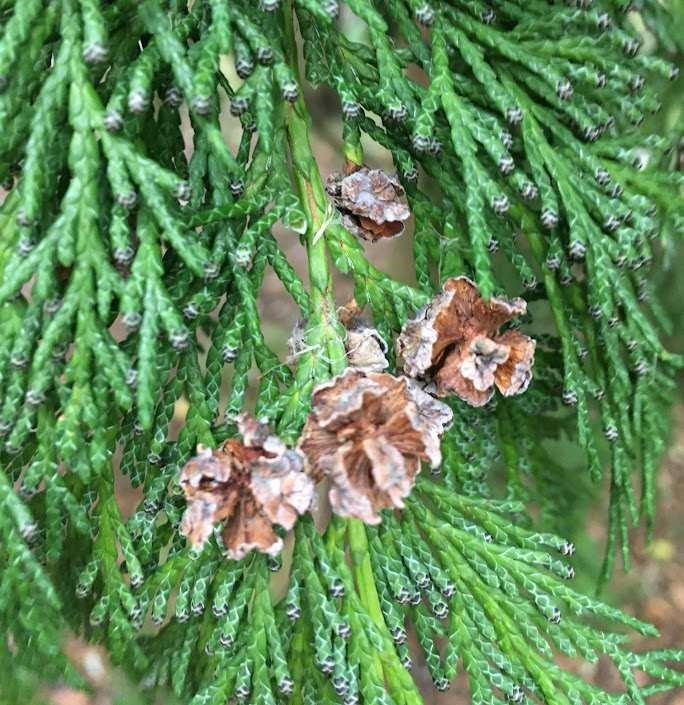 Coupled with variations from seed, this resulted in a number of cultivars appearing in nursery catalogues and made it a popular tree for Victorian parks, churchyards and large gardens. Barnwood Park has six of the original cultivar in the arboretum area and more in the park. In addition, there are seven multi-stemmed cultivars to the east of the chapel and the tree register shows five of a golden-leaved variety in the park. See if you can work out which ones!
Coupled with variations from seed, this resulted in a number of cultivars appearing in nursery catalogues and made it a popular tree for Victorian parks, churchyards and large gardens. Barnwood Park has six of the original cultivar in the arboretum area and more in the park. In addition, there are seven multi-stemmed cultivars to the east of the chapel and the tree register shows five of a golden-leaved variety in the park. See if you can work out which ones!
During the last 50 years nurseries have bred smaller cultivars more suited to modern gardens. The RHS website list includes Chamaecyparis lawsoniana ‘Minima glauca’ which grows slowly to a mere one metre tall.
Italian Alder – alnus cordata
Alnus cordata is a more ornamental tree than our native alder, alnus glutinosa, and was introduced into Britain from southern Italy for planting in parks and large gardens. It grows taller, up to 25 metres, in a conical shape and can also be distinguished by its larger cones and catkins.
Like the native alder it is late to shed its slightly glossy leaves, which are more heart shaped in Italian alder.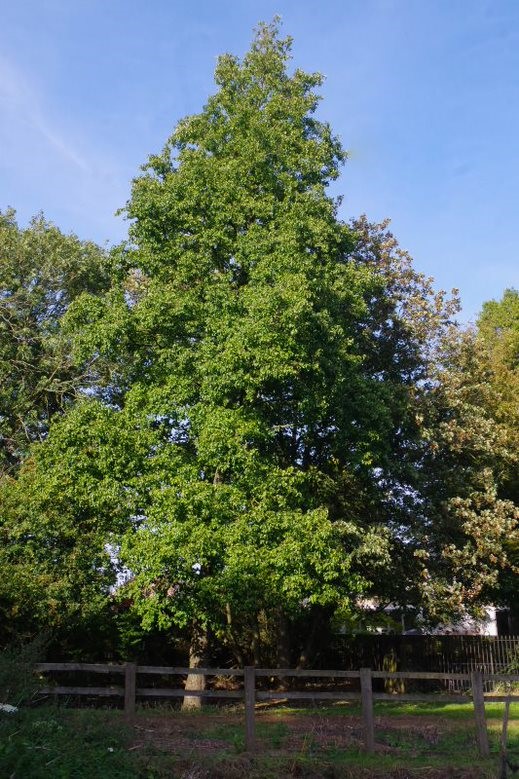 Alder cones stay on the tree all year round and by late summer fresh green cones can be seen with the old brown ones. The ripe seeds are popular in winter with goldfinches. Yellow male catkins 4-8 cms long appear in February before the new leaves.
Alder cones stay on the tree all year round and by late summer fresh green cones can be seen with the old brown ones. The ripe seeds are popular in winter with goldfinches. Yellow male catkins 4-8 cms long appear in February before the new leaves.
Alders are fast growing trees but fairly short-lived, a lifespan of 60 to 100 years being usual.
Alders generally like damp soil but alnus cordata tolerates drier soils, making it a more useful tree for parks.
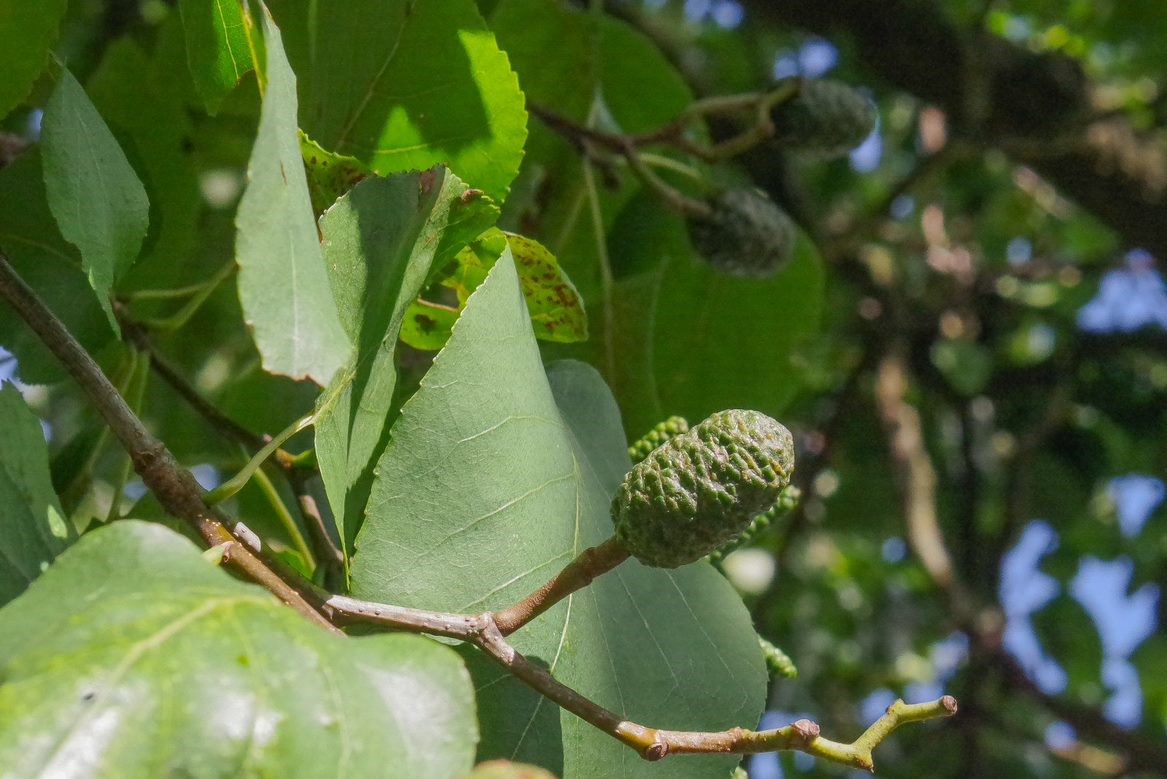
Interesting fact:
Fully submerged alder wood does not rot. Venice was built on alder piles.
Cherry Laurel - Prunus laurocerasus
Cherry Laurel (or Common Laurel) is a stocky spreading evergreen tree, a native of the Balkans and Black Sea area. It grows to 8 metres tall, if left to its own devices, however nowadays in Britain it is most commonly seen in urban areas in the form of clipped evergreen hedges. The leaves are oval in shape, glossy on top and leathery, and when crushed or cut give off a sharp almond smell.
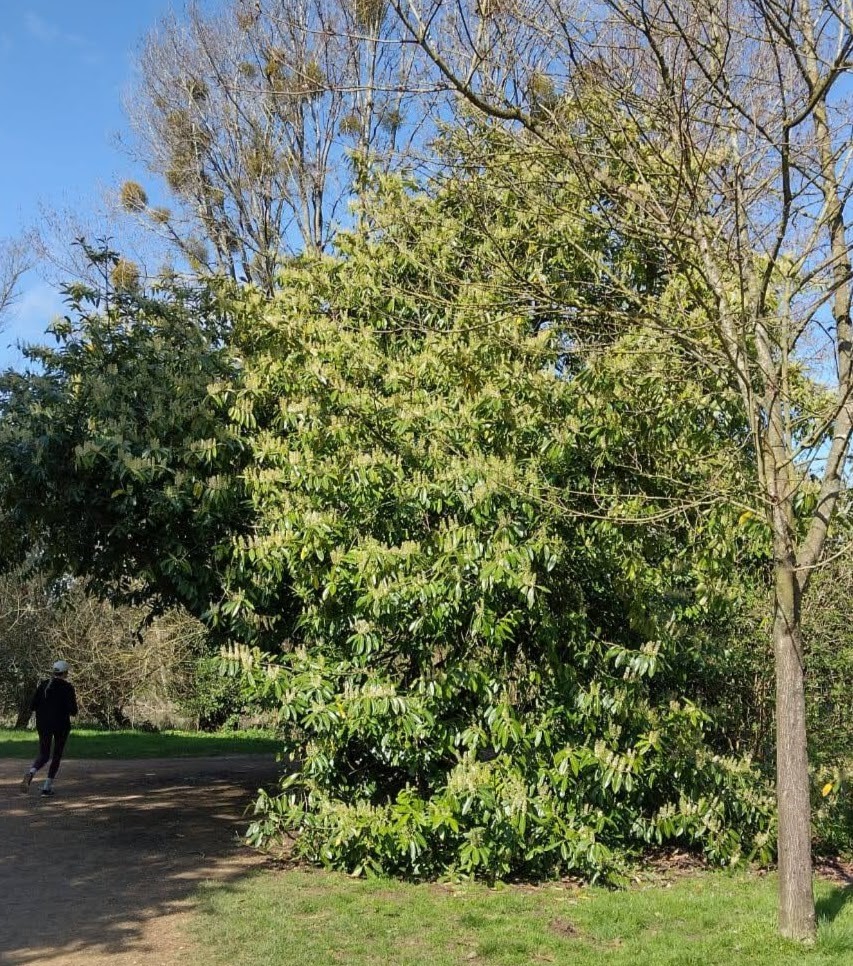 In Spring new pale green shoots grow, with fragrant white flowers in upright spikes 10 to 15 cm long during April. They are nectar rich and popular with insects. Flowers are followed by small red cherry-like fruits which turn black as they ripen. The fruits should not be eaten as they can contain cyanide toxins (they do if they are bitter) as do the stones, always. The leaves are poisonous to humans and most animals, although being very bitter are unlikely to be eaten. Birds can eat the fruit without harm.
In Spring new pale green shoots grow, with fragrant white flowers in upright spikes 10 to 15 cm long during April. They are nectar rich and popular with insects. Flowers are followed by small red cherry-like fruits which turn black as they ripen. The fruits should not be eaten as they can contain cyanide toxins (they do if they are bitter) as do the stones, always. The leaves are poisonous to humans and most animals, although being very bitter are unlikely to be eaten. Birds can eat the fruit without harm.
Cherry Laurel is considered a nuisance in some woodlands in the UK. It is very adaptable to soil conditions, grows from seed and suckers, grows well in shade, and even deer dislike its leaves. Casting year-round shade it can eventually out compete other woodland plants and prevent tree seedlings from growing, a real survivor.
Weeping Willow
Salix babylonica / Salix chrysocoma
The weeping willow is a large ornamental tree which, like all willows, thrives in moist soil. There are two in Barnwood Park by the stream towards the Cherston Court entrance; one has been pollarded. They have long been popular in parks and large gardens, planted beside water - they do need plenty of space to safely accommodate their roots, so not one for the smaller garden. Mature trees reach a height and spread of 12 metres.
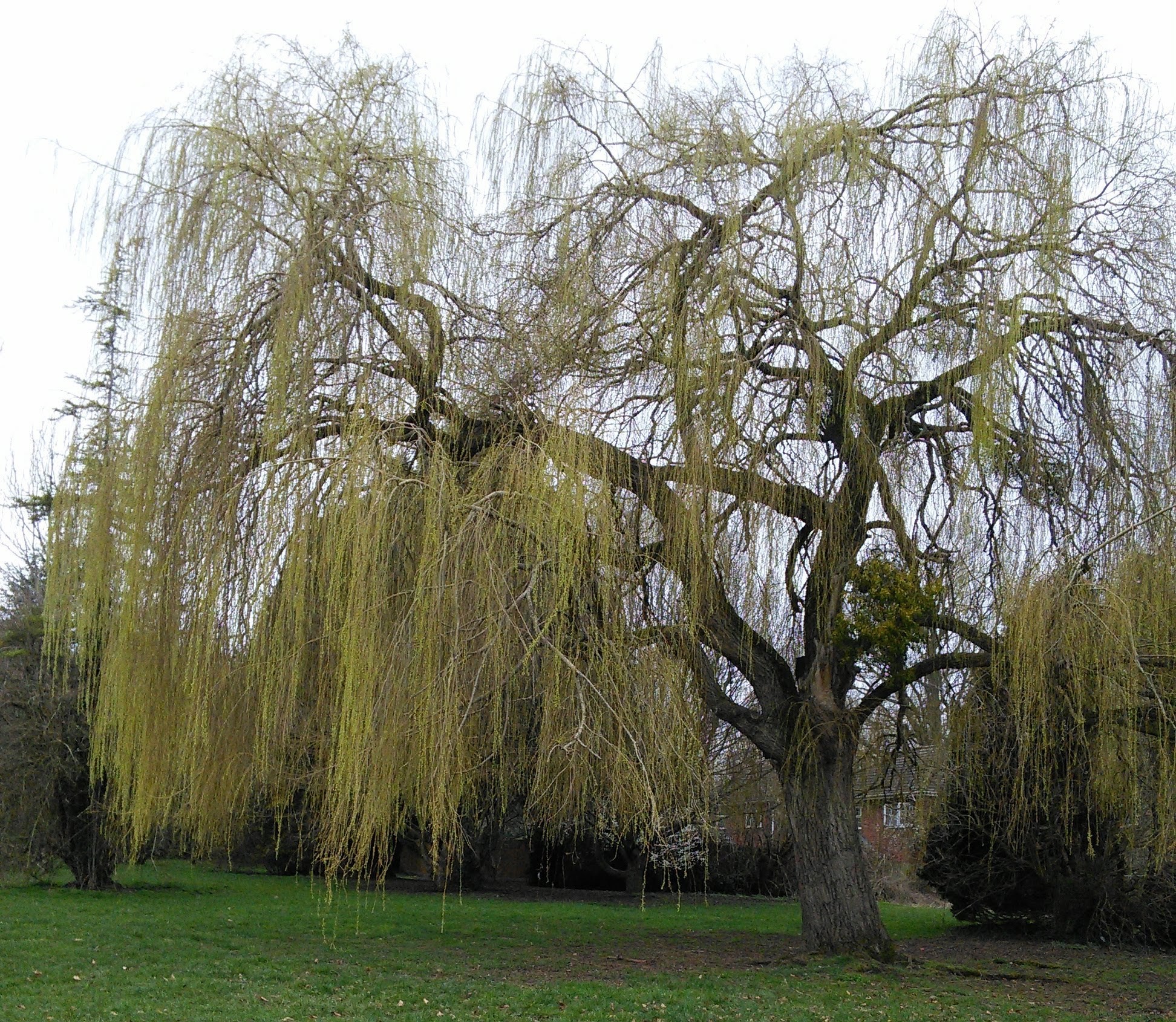 Graceful drooping branches and slender shoots which move in the breeze, make for a fine specimen tree at any time of year. Over winter the year’s new growth stands out bright yellowish green. From March a light green haze cloaks the shoots as catkin and leaf buds begin to open.
Graceful drooping branches and slender shoots which move in the breeze, make for a fine specimen tree at any time of year. Over winter the year’s new growth stands out bright yellowish green. From March a light green haze cloaks the shoots as catkin and leaf buds begin to open.
The weeping willow originated in ancient China. Trees were traded along the ‘Silk Road’ west to the Middle East initially, then into Europe at the beginning of the 18th century. By 1730 London nurserymen were listing it in their catalogues. As it was thought at the time to be native to the Middle East, it was officially classified in 1753 as Salix Babylonica. Subsequently a hybrid, Salix Chrysocoma, with more golden stems and leaves was bred and it is likely that this is what ours are here.
The tree is depicted on the blue and white china known as ‘Willow Pattern’. The first Blue Willow china was made in England by the Caughley Pottery in Shropshire in 1790 in response to the fashion for imported blue and white Chinese porcelain.
Holm Oak - Quercus ilex
Holm Oak is an evergreen tree, which you might not recognise as an oak tree at all until the acorns arrive in autumn. Much shorter at maturity than English oak, growing to around 20 metres tall, it is a wide spreading tree. It can be found in the Park on the right past the Cherston Court entrance.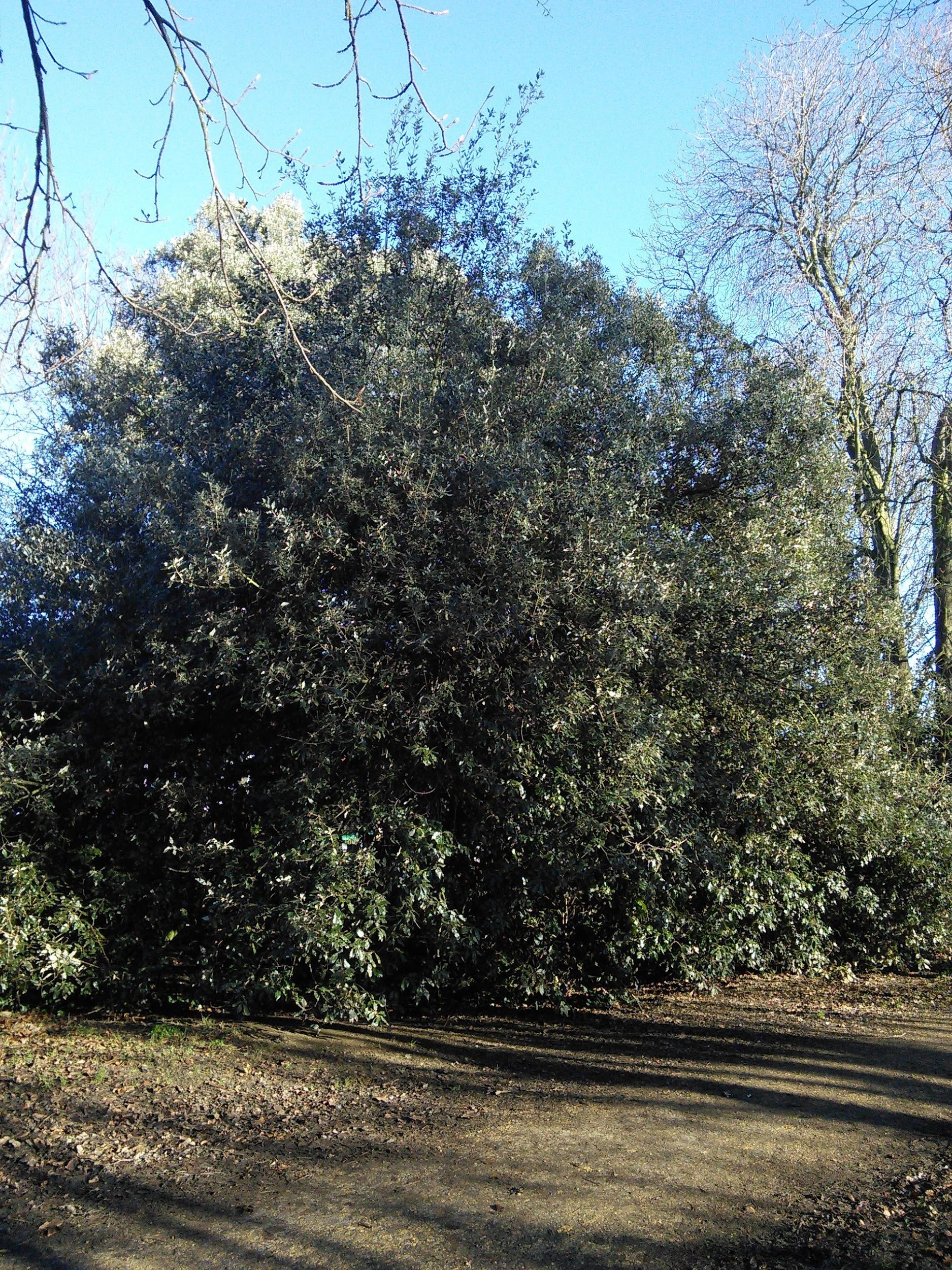
It has oval dark green leathery leaves some of which develop short spines rather like holly, hence 'ilex', the Latin name for the holly family. The underside of the leaf is pale grey and felted with short fine hairs, a common feature of plants growing in dry sunny places. Holm Oaks are native to the northern shores of the Mediterranean, first arriving in England in the Tudor period. They are particularly associated with Spain where its acorns (at 6 to 10 kilos a day) feed the pigs which produce Iberico ham.
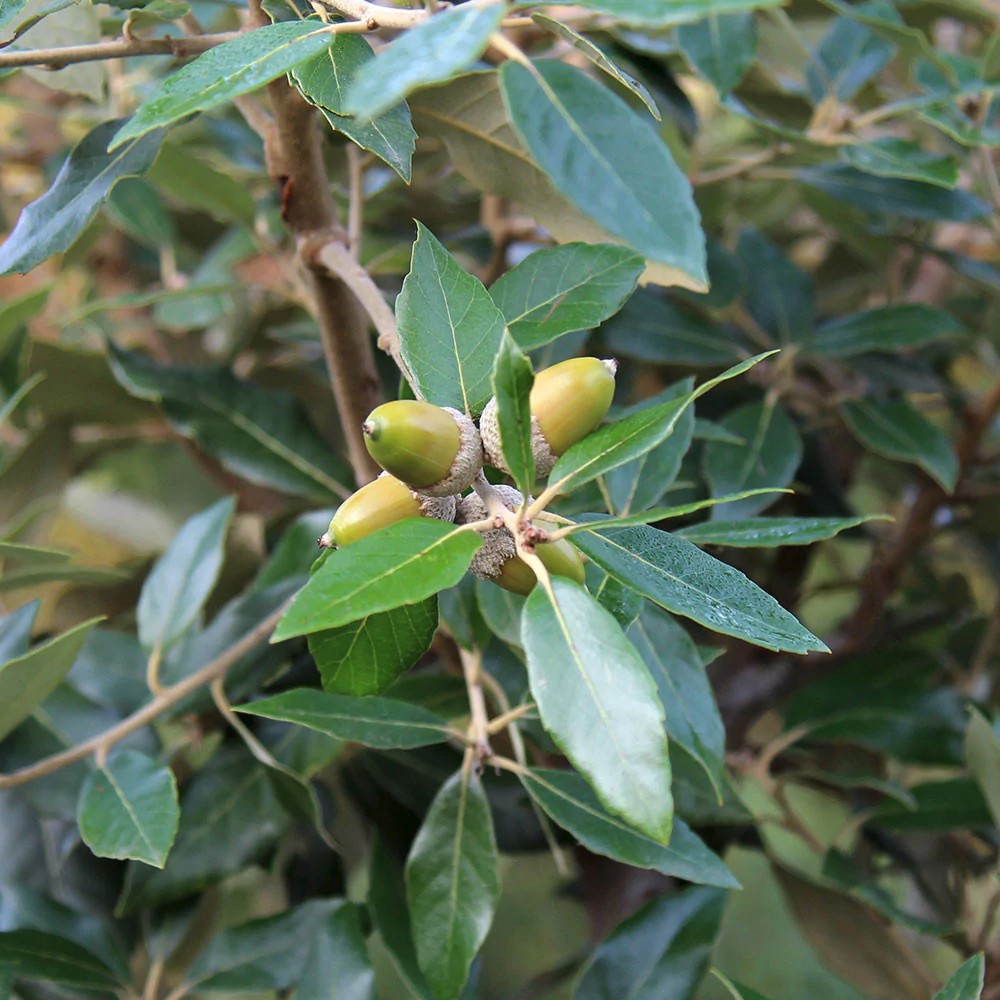 Golden catkins appear on the tree in late spring and every few years all trees in a neighbourhood have a 'mast year' when they produce a bumper crop of acorns to ensure enough survive predators to grow into new plants. This synchronising means that predator populations don't have an opportunity to adjust their numbers to benefit from the crop.
Golden catkins appear on the tree in late spring and every few years all trees in a neighbourhood have a 'mast year' when they produce a bumper crop of acorns to ensure enough survive predators to grow into new plants. This synchronising means that predator populations don't have an opportunity to adjust their numbers to benefit from the crop.
The Holm Oak grows well on mild coasts as it resists salt spray and has also proved of value as an urban tree because it tolerates shade and pollution well. It can be clipped and became popular in parks in the 19th century.
Swamp Cypress - Taxodium Distichum
South Eastern USA is the home of the Swamp Cypress and they are a feature of the Florida Everglades. Plant hunter John Tradescant introduced it to Britain in 1640. As its name suggests, it is happy in waterlogged and flood-prone areas where other trees might not survive. When growing in swamps its roots emerge from the ground to form knees before turning back down. It is thought these knees absorb oxygen from the air to compensate for the lack of oxygen in waterlogged soil. However, research continues as this does not provide a fully satisfactory explanation. Although it bears cones which look like those of the cypress, it is not a true cypress. Its leaves resemble those of a Yew in shape, though lighter in colour, but it is not an evergreen; its leaves turn russet-red before falling in November.
It has much in common with the Dawn Redwood though this has leaves and shoots in opposite pairs rather than alternate. Our Swamp Cypress is on the Weir Path in the Arboretum by the brook.
Walnut - Juglans regia
The walnut is a deciduous broad-leaved tree that can grow to 35m. Each leaf has 5 to 9 oval leaflets, increasing in size towards the tip. 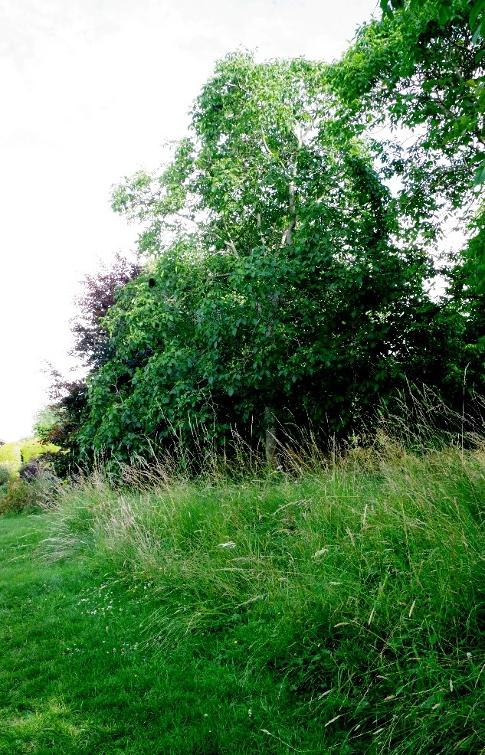 Young leaves are bronze coloured and smell like polish when crushed. Male flowers appear in May/June and are drooping yellow-green catkins, 5–10 cm long, and the female flowers appear in clusters of 2–5. Pollinated by wind, female flowers develop into a fruit with a green, fleshy husk and a brown, wrinkled walnut.
Young leaves are bronze coloured and smell like polish when crushed. Male flowers appear in May/June and are drooping yellow-green catkins, 5–10 cm long, and the female flowers appear in clusters of 2–5. Pollinated by wind, female flowers develop into a fruit with a green, fleshy husk and a brown, wrinkled walnut.
Originally from Asia, the walnut was introduced to Britain by the Romans who ate the nuts and used them to make cooking oil. The resemblance of the peeled nut to the human brain led to the medieval belief that it could cure mental disorders. Over the centuries it has had many practical uses, including furniture making, soap manufacture and boiling the leaves to make a liquid to kill slugs. Juglans regia means the “Royal Nut of Jupiter”. 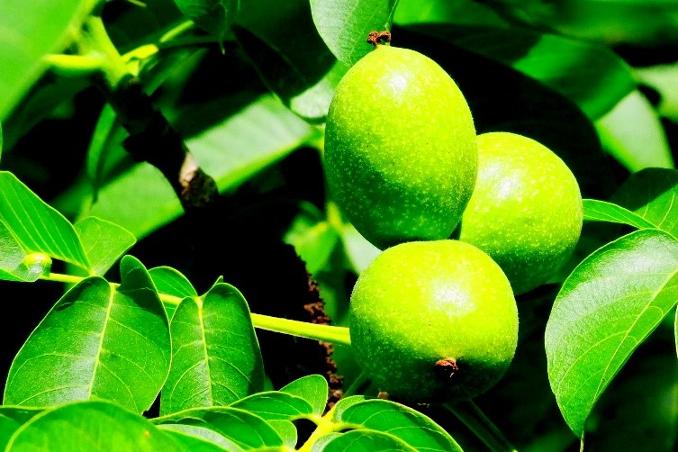 The leaves are the foodplant for caterpillars of a number of micro moths and the nuts are eaten by mammals, especially mice and squirrels, which often eat or hoard them before they can be harvested by humans.
The leaves are the foodplant for caterpillars of a number of micro moths and the nuts are eaten by mammals, especially mice and squirrels, which often eat or hoard them before they can be harvested by humans.
Sweet Chestnut - Castanea sativa
There is a Sweet chestnut overlooking the Balancing Pond. It is a long-lived deciduous tree, of the same family as beech and oak. It has long, glossy leaves with pointed tip and widely serrated edges, arranged alternately along stems - unlike the horse chestnut's hand-shaped arrangement.
Note: Despite their common names, sweet chestnut and horse chestnut are not related. Fruits of horse chestnut (conkers) are mildly toxic to humans.
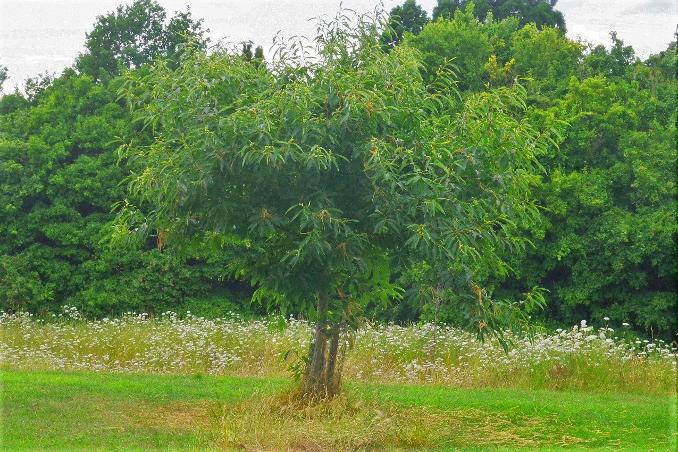 Native to southern and eastern Europe, sweet chestnut has been cultivated for over 2,000 years for food and timber. The name ‘castanea’ refers to the town of Castonis in northern Greece where it was grown for nuts. The Romans may have introduced it to Britain, as we know they used flour made from ground chestnuts. It now grows wild here, particularly in woods in southern England where it is still managed by coppicing to provide fencing poles and rails. Its shiny brown fruits develop within a very spiky green case, often 2 in a case, once the tree is over 20 years old. Greeny-yellow flowers in catkin-like spikes appear in late June or July.
Native to southern and eastern Europe, sweet chestnut has been cultivated for over 2,000 years for food and timber. The name ‘castanea’ refers to the town of Castonis in northern Greece where it was grown for nuts. The Romans may have introduced it to Britain, as we know they used flour made from ground chestnuts. It now grows wild here, particularly in woods in southern England where it is still managed by coppicing to provide fencing poles and rails. Its shiny brown fruits develop within a very spiky green case, often 2 in a case, once the tree is over 20 years old. Greeny-yellow flowers in catkin-like spikes appear in late June or July.
In rugged areas of its native region, where cereal crops were harder to grow, flour made from roast and ground nuts was a valuable food source in the past, having similar starch levels to wheat flour. Chestnut woodlands were managed spaces, with sheep or pigs keeping the ground clear beneath trees.
On the Mediterranean island of Corsica chestnut cultivation has been revived in recent decades following drastic decline after WWI. Chestnuts and chestnut flour feature prominently in local cuisine and there is even a local beer, Pietra, brewed from the flour.
Western Balsam Poplar – populus trichocarpa
The Western Balsam Poplar or Black Cottonwood is a vigorous tall deciduous broadleaf tree with a columnar form. A champion tree in Lydney Park was measured as 40m tall with a girth of 2.88 m in 2015. As it ages the crown becomes broader and rounder and the initially smooth bark begins to flake and in old trees is deeply fissured. It can be seen in the Arboretum next to the entrance.
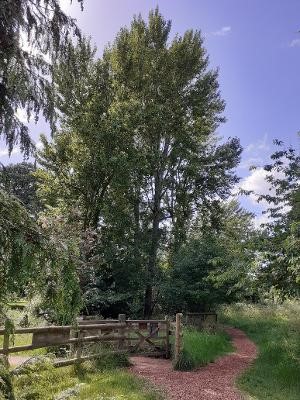 Balsam refers to the protective, sticky substance that protects the delicate leaf buds and gives the tree a distinctive aromatic smell. Wild bees collect the balsam, which they mix with saliva and beeswax to seal gaps in their hives. The ornamental red male and less showy green female catkins are borne on separate plants and it is wind pollinated. Like a willow, to which it is related, the seeds are covered in fluffy white hairs to aid dispersal – hence, cottonwood.
Balsam refers to the protective, sticky substance that protects the delicate leaf buds and gives the tree a distinctive aromatic smell. Wild bees collect the balsam, which they mix with saliva and beeswax to seal gaps in their hives. The ornamental red male and less showy green female catkins are borne on separate plants and it is wind pollinated. Like a willow, to which it is related, the seeds are covered in fluffy white hairs to aid dispersal – hence, cottonwood.
A native of the Pacific Northwest of America, it is the largest poplar species of the Americas. Its rapid growth rate makes it commercially important for use in plywood, pallets, cheap furniture etc. It was introduced into the UK in the 1890s and in 15 years Kew’s largest specimen had grown to 55 ft. It readily suckers and its extensive root system makes it unsuitable to plant near buildings. It was the first tree to have its genome fully sequenced.
Black Mulberry - Morus nigra
The Black Mulberry is a small, broad-crowned deciduous tree with heart-shaped, dark green leaves. Its greenish flowers are insignificant. Its dark purplish-red fruit are around 2cm in length. They may be harvested in late summer by placing a sheet on the ground and shaking the tree. Too delicate when ripe to be commercially valuable, they can be used in jams and desserts or dried for use as a snack.
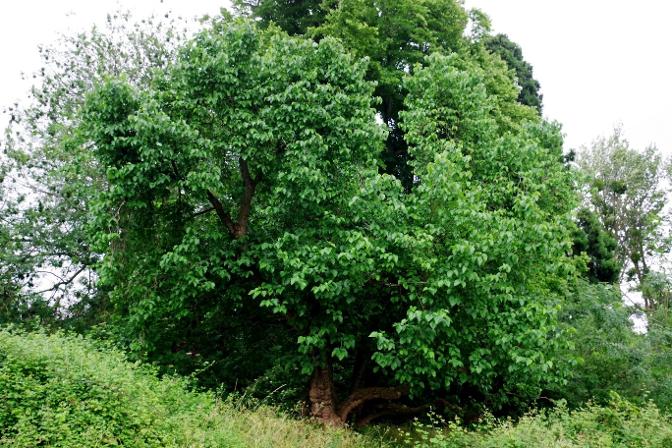 Thought to have originated in the mountainous regions of Mesopotamia and Persia, the mulberry has long been established in England. Seeds have been found by archaeologists on Roman sites and the tree was grown in the herb gardens of medieval monasteries. James I actively encouraged its cultivation in the hope of establishing a silk industry in England. Contrary to common belief silkworms will eat the leaves, although they prefer those of the White Mulberry. While the silkworms produced finer silk on their preferred diet, the Black Mulberry flourished better in the English climate.
Thought to have originated in the mountainous regions of Mesopotamia and Persia, the mulberry has long been established in England. Seeds have been found by archaeologists on Roman sites and the tree was grown in the herb gardens of medieval monasteries. James I actively encouraged its cultivation in the hope of establishing a silk industry in England. Contrary to common belief silkworms will eat the leaves, although they prefer those of the White Mulberry. While the silkworms produced finer silk on their preferred diet, the Black Mulberry flourished better in the English climate.
The Black Mulberry is long lived. An ancient tree in Syon Park, West London is reputed to have been planted by the naturalist William Turner a year after the death of Henry VIII (1548). According to Turner, the mulberry ‘looseth the belly and it is good for the stomach’, although its modern medicinal use is limited to making a syrup to ease the taking of less palatable ingredients.
Silver Birch - Betula pendula
There is a Silver Birch in the Arboretum on the left at the top of the main path. Native to the UK and a large swathe of the northern hemisphere as it tolerates very low temperatures. Its range extends up to the Arctic Circle and birch forests spread east from the Baltic States into Siberia. In 1988 it was chosen by popular vote as the national tree of Finland. It thrives on heaths and dry woodland and is a coloniser species, moving quickly onto bare land thanks to its tiny winged seeds dispersed by the wind.
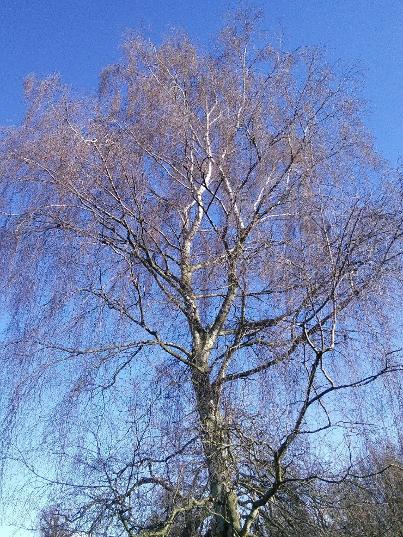 Silver Birch is one deciduous tree easy to recognise in winter because of its shape, with elegant drooping branches, slender twigs and bright white bark. The smooth bark sheds in tissue paper thin layers to renew but as the tree gets older it develops dark diamond shaped corky patches on the trunk. In autumn its small, triangular, light green leaves turn a beautiful yellow before dropping.
Silver Birch is one deciduous tree easy to recognise in winter because of its shape, with elegant drooping branches, slender twigs and bright white bark. The smooth bark sheds in tissue paper thin layers to renew but as the tree gets older it develops dark diamond shaped corky patches on the trunk. In autumn its small, triangular, light green leaves turn a beautiful yellow before dropping.
Birch twigs are sometimes infected by the fungus Taphrina which causes them to branch chaotically into what look like nests, traditionally known as ‘witch's brooms’. Flowers in the form of catkins appear in April and May, male and female on the same tree. Male catkins are yellowy brown in groups of 2 to 4 at the end of twigs and resemble lambs tails, while smaller female catkins are pale green and occur singly. Pollen from the male catkins is wind dispersed and can cause allergic rhinitis (hayfever) in those susceptible.
Silver Birch provides food and habitat for more than 300 insects, including caterpillars of many moths. Its seeds are popular with siskins and other finches. The tree is also associated with certain fungi, in particular birch polypore, a type of bracket fungi, and the poisonous red and white spotted fly agaric. Birch bark is used for tanning leather and in the past the hard, heavy wood was used for bobbins, spools and reels for the Lancashire cotton industry. In northern Europe today it is a source for plywood and wood pulp.
Ornamental Plum – Prunus cerasifera nigra
This Ornamental Plum can be found in the Arboretum at the top of the path leading straight on from the bridge. A small to medium tree growing to 10 metres, its deciduous leaves are very dark purple, as indicated by ‘nigra’ in the name. 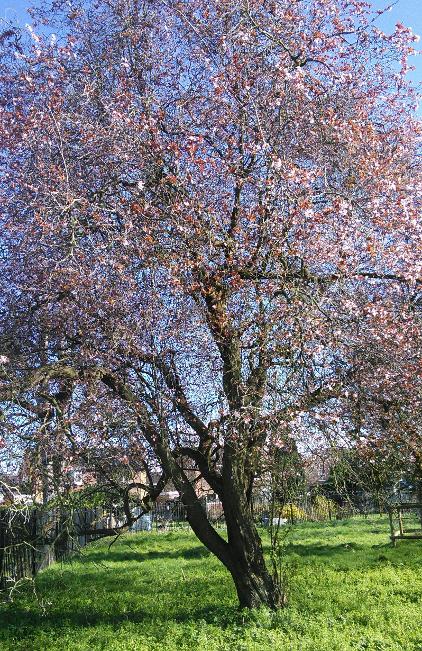 It is hardy and tolerant of a range of growing conditions and has been widely planted in parks and gardens in Britain. In early spring it has pale pink flowers providing early nectar for honey bees; this year it started flowering in the last week of February. Later in the year it has small dark red, rather sour plums.
It is hardy and tolerant of a range of growing conditions and has been widely planted in parks and gardens in Britain. In early spring it has pale pink flowers providing early nectar for honey bees; this year it started flowering in the last week of February. Later in the year it has small dark red, rather sour plums.
Purple leaved trees are grown best in full sun as in shade their leaves take on duller, dark green tones. Purple leaves have high levels of anthocyanin, which reflects red light so we see red and purple tones, and lower levels of chlorophyll, which reflects green light. In shade the plant has to increase the amount of chlorophyll being produced to aid photosynthesis so green takes over.
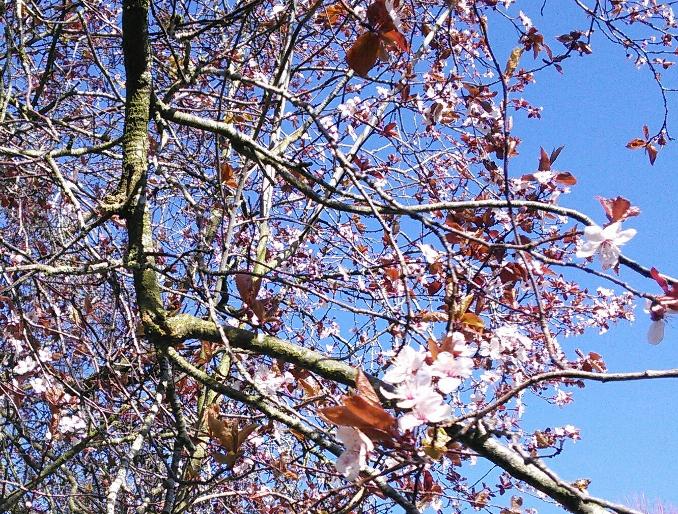 Prunus cerasifera in its green form is native to SE Europe and W Asia, growing in open woodland and forest edge. It became naturalised in Britain where it is commonly called the Cherry Plum owing to the appearance of its fruit and it is the ancestor of the domestic plum tree Prunus domestica. There are more than 200 species of Prunus, including the peach Prunus persica and the almond Prunus dulcis.
Prunus cerasifera in its green form is native to SE Europe and W Asia, growing in open woodland and forest edge. It became naturalised in Britain where it is commonly called the Cherry Plum owing to the appearance of its fruit and it is the ancestor of the domestic plum tree Prunus domestica. There are more than 200 species of Prunus, including the peach Prunus persica and the almond Prunus dulcis.
Blackthorn – Prunus spinosa
Blackthorn is native throughout the British Isles, growing in hedgerows and woodland edges. It can grow to 6 metres and survive for up to 100 years. It is the first native shrub or tree to flower in the year from mid-February onwards. The white flowers with 5 petals and red-tipped anthers appear before the leaves. Blackthorn has long thorns and small, blue-black fruits, commonly known as sloes. The trunks produce numerous suckers that can quickly form a thicket. Special varieties of blackthorn are cultivated for gardens, including “Purpurea”, with purple leaves and “Rosea” with salmon-pink flowers.
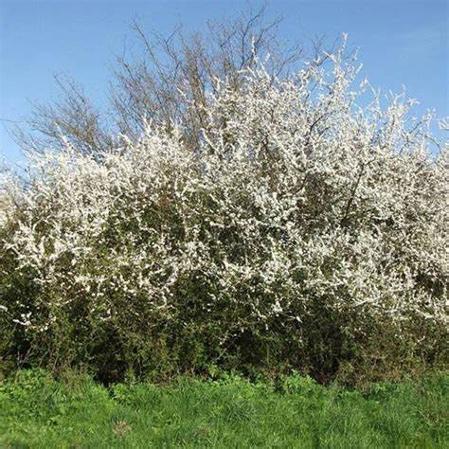 It is thought that blackthorn may be one of the parents of the damson and other domestic plums. Sloes are used to make wine, preserves and sloe gin. The timber, which is yellow/orange, is very tough and is used to make riding or walking sticks. The flowers provide a rich source of pollen and nectar for bees in the early spring and the caterpillars of the brown and black hairstreak butterfly and numerous moths feed on its leaves. Birds feed on the caterpillars and fruit and find protection amongst the thorns for nesting.
It is thought that blackthorn may be one of the parents of the damson and other domestic plums. Sloes are used to make wine, preserves and sloe gin. The timber, which is yellow/orange, is very tough and is used to make riding or walking sticks. The flowers provide a rich source of pollen and nectar for bees in the early spring and the caterpillars of the brown and black hairstreak butterfly and numerous moths feed on its leaves. Birds feed on the caterpillars and fruit and find protection amongst the thorns for nesting.
Rowan - Sorbus aucuparia
Commonly known as the Mountain Ash, Rowan trees are not related to Ash trees, despite the similarity in leaf shape. Rowans are graceful, open, deciduous trees that are native to the UK and can live for up to 200 years. 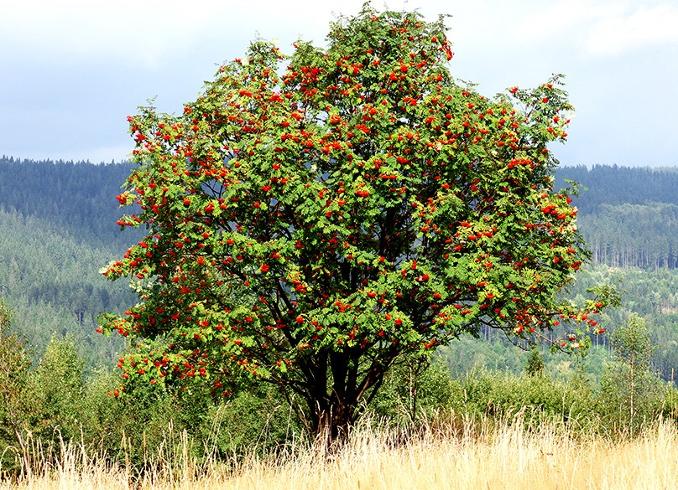 They are often found in the wild on mountain sides but are also popular as street or garden trees. The bark is smooth, shiny and grey with pores and the tree grows up to 20 metres in height. The tree has creamy-white clusters of flowers in May and red berries in autumn, although there are cultivars with yellow berries, like the one in Barnwood Park, which can be found to the right of the main path past the bridge to the Arboretum. The red berries were thought to ward off witches and evil spirits so Rowans were often planted in churchyards and outside houses.
They are often found in the wild on mountain sides but are also popular as street or garden trees. The bark is smooth, shiny and grey with pores and the tree grows up to 20 metres in height. The tree has creamy-white clusters of flowers in May and red berries in autumn, although there are cultivars with yellow berries, like the one in Barnwood Park, which can be found to the right of the main path past the bridge to the Arboretum. The red berries were thought to ward off witches and evil spirits so Rowans were often planted in churchyards and outside houses.
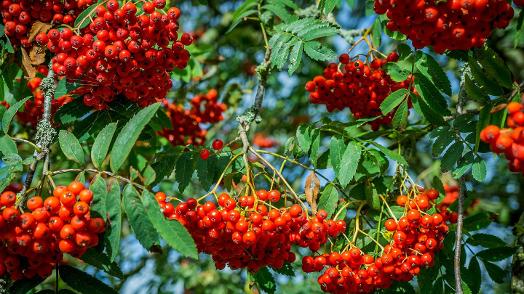 Rowan leaves are eaten by several moth caterpillars and the flowers provide pollen and nectar for bees and pollinating insects. The berries are eaten by blackbirds, mistle thrushes, redstarts, redwing, fieldfare, song thrush and waxwings. They are also edible to humans, are rich in vitamin C and can be used to make a tart jelly to be eaten with game.
Rowan leaves are eaten by several moth caterpillars and the flowers provide pollen and nectar for bees and pollinating insects. The berries are eaten by blackbirds, mistle thrushes, redstarts, redwing, fieldfare, song thrush and waxwings. They are also edible to humans, are rich in vitamin C and can be used to make a tart jelly to be eaten with game.
Ginkgo Biloba
The Ginkgo Biloba is a species of tree native to China and is one of the oldest living tree species in the world. In fact, it predates dinosaurs and is referred to as a ‘living fossil’, like the Wollemi Pine, another tree that can be seen in the Arboretum. Both these trees were thought to be extinct until being rediscovered. Fossils of Ginkgo leaves have been found dating back more than 200 million years and are almost identical to the Ginkgo tree leaves of today.
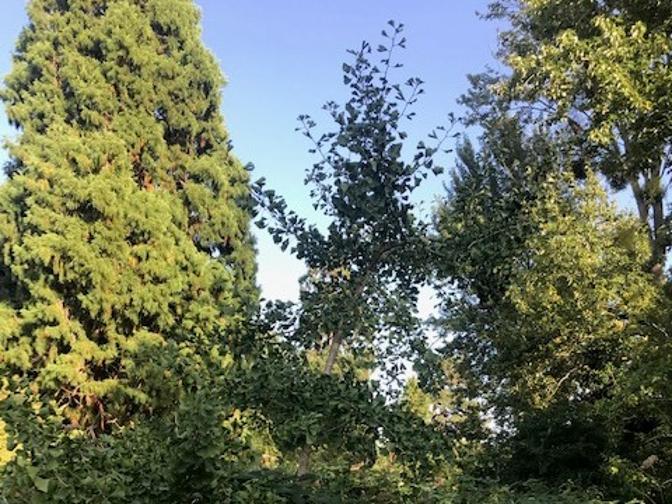 Ginkgo trees are ‘dioecious’ which means that some trees are male and others are female. The male trees produce pollen cones whilst the female trees develop two ovules at the end of a stalk. After pollination one or both develop into seeds. The seed has a fleshy outer layer like a fruit. The trees are large at 20 to 35 metres with deep roots that help to make them resistant to wind damage. In autumn, the leaves turn bright yellow before quickly falling. The trees are disease and insect resistant with regenerative characteristics. Some specimens are claimed to be over 2,500 years old.The Ginkgo's tenacity may be seen in Hiroshima, Japan, where six trees growing within a mile of the atomic bomb explosion were among the few living things in the area to survive the blast. The Ginkgo trees, though charred, survived and were able to grow healthily again. These six trees are still alive.
Ginkgo trees are ‘dioecious’ which means that some trees are male and others are female. The male trees produce pollen cones whilst the female trees develop two ovules at the end of a stalk. After pollination one or both develop into seeds. The seed has a fleshy outer layer like a fruit. The trees are large at 20 to 35 metres with deep roots that help to make them resistant to wind damage. In autumn, the leaves turn bright yellow before quickly falling. The trees are disease and insect resistant with regenerative characteristics. Some specimens are claimed to be over 2,500 years old.The Ginkgo's tenacity may be seen in Hiroshima, Japan, where six trees growing within a mile of the atomic bomb explosion were among the few living things in the area to survive the blast. The Ginkgo trees, though charred, survived and were able to grow healthily again. These six trees are still alive.
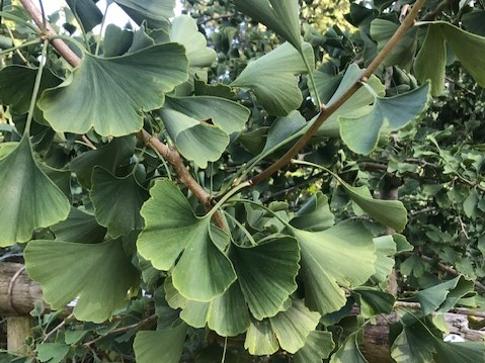 Ginkgo seeds and leaves have been used in traditional Chinese medicine for many centuries and extracts of Ginkgo leaves are often marketed as memory enhancers but there is little evidence to support this.
Ginkgo seeds and leaves have been used in traditional Chinese medicine for many centuries and extracts of Ginkgo leaves are often marketed as memory enhancers but there is little evidence to support this.
There is a Ginkgo biloba tree in the Arboretum to the left of the weir path just beyond the pond as you walk towards the bridge.
Beech - Fagus sylvatica purperea
The beech tree is a large, shallow rooted, deciduous tree native to southern England. It is the dominant native species on chalk and limestone. Beech is widely planted in parks as well as being popular for hedging, where it can be used as an alternative to an evergreen due to it retaining its dead leaves through the winter. The early spring leaves are attractive and it has excellent autumn colour. It thrives in a wide variety of soils and there are many ornamental varieties. There are several varieties of beech tree in Barnwood Park. The one pictured here is a copper beech and there is a very rare variegated beech in the Arboretum (opposite the wildlife pond).
Beech bark is smooth and grey and the wood is strong and can be turned easily, making it ideal for furniture, particularly chairs, and it is also used for kitchen utensils and children’s toys. Beechmast (nuts) make good pig feed and is widely eaten by mice, squirrels and birds. Bats like to roost in holes in the trunk.
Beechwoods cast dense shade which creates ideal conditions for bird’s-nest orchids, ghost orchids and helleborines. Some ninety four species of invertebrates have been found in beech trees, including lobster and barred hook-tip moths.
Oak - Quercus robur
There are two types of oak that are native to Britain - the English or pedunculate oak (Quercus robur) which can be found in the Arboretumand the Sessile oak (Quercus petraea). 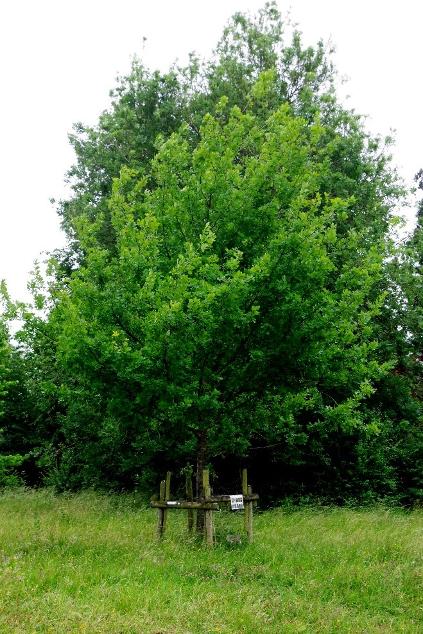 Sessile oaks tend to grow in upland areas and English oak in lowland regions. On pedunculate (English) oak the acorns are borne on stalks or “peduncles” and the leaf stalks are very short in contrast to the Sessile oak. Male flowers appear with the first leaves as pale green catkins and the female flowers on spiked stalks behind them.
Sessile oaks tend to grow in upland areas and English oak in lowland regions. On pedunculate (English) oak the acorns are borne on stalks or “peduncles” and the leaf stalks are very short in contrast to the Sessile oak. Male flowers appear with the first leaves as pale green catkins and the female flowers on spiked stalks behind them.
Oak wood has always been valued for its strength and durability and has been used down the centuries for ship building and for roof timbers for grain barns and cathedrals. In the Middle Ages the demands of the navy led to the extensive planting of oaks in royal forests, many surviving to this day, where they are among Britain’s oldest trees. Oaks were frequently pollarded to encourage the growth of large branches. Oaks were an important food source for pigs that were turned loose into the forests in the autumn. This was known as the right of “pannage” and is still available to commoners living in the New Forest. The oak tree is especially valuable for wildlife and supports more species than any other native British tree.
Wild Service tree - Sorbus torminalis
Native to the UK and parts of Europe, Africa and Asia this is a relatively rare tree species in this country, confined mainly to the South and Midlands. Usually associated with Oak and Ash woods and is an Ancient Woodland indicator species.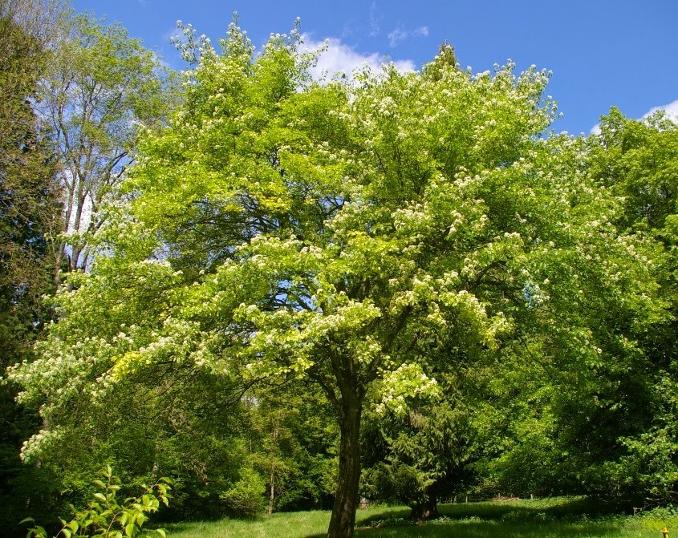
The bark is brown and becomes patterned with square plates as it matures - a bit like Sycamore and Horse Chestnut do. Its hairless leaves are maple-like with uneven lobes and two lobes at the base that project almost at right angles; pale green becoming darker and leathery, in Autumn they are a coppery red colour. The buds are green, arising alternately on the twigs. Flowers are creamy white in clusters, similar to many of its cousins (e.g. Rowan, Whitebeam); fruits are oval, greeny-brown and need to be left to decay, as with medlars, before they are edible - a process known as ‘bletting’ can also make them edible (through freezing). 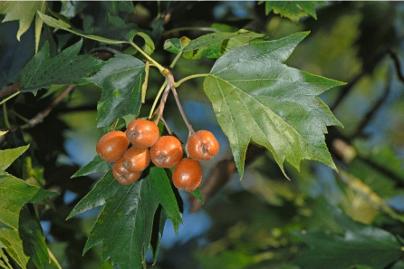 The fruits are often called chequers and were once used to flavour beer (before hops were available), along with other alcoholic drinks such as whisky.
The fruits are often called chequers and were once used to flavour beer (before hops were available), along with other alcoholic drinks such as whisky.
The wood of the Wild Service tree is fine grained and has been used for making screws for wine presses as well as billiard cue sticks. Parts of the tree were used as a herbal remedy for colic (its Latin name torminalis is said to mean ‘good for colic’).
Whitebeam - Sorbus aria
The Whitebeam in the Arboretum was planted in memory of Tom Meeks, the first Chairperson of the Friends group. The Whitebeam is native to the British Isles. It grows to between 15 and 25 metres. The wood is hard and tough and was used to make cogs in early machinery before it was replaced by iron. The berries were made into jelly to accompany venison and the Anglo-Saxons used it as a boundary tree because of its distinctive appearance.
The hairy, silvery-white undersides of the leaves resist pollution and help the tree conserve moisture as well as making the tree appear to be covered in blossom from a distance before the flowers emerge. It prefers chalk and lime rich soils but will tolerate other conditions. It makes an excellent street tree. The creamy-white flowers appear in May and are sweetly scented. The flowers attract insects, particularly the white caterpillar of the tiny Argynesthia moth that feeds on the shoots and flower buds. The bright red berries are eaten by birds and the leaves turn golden in the autumn. There are numerous varieties of whitebeam, resulting from natural and human hybridisation.
Horse Chestnut Tree - Aesculus hippocastanum
Mature horse chestnut trees grow to 40 metres and can live for 300 years. The palmate leaves comprise 5-7 pointed leaflets spreading from a central stem. Appearing in May, the clustered flowers are white with a pink flush at the base. They are a rich source of nectar and pollen for insects, particularly bees. Once pollinated, each flower develops into a glossy red-brown conker inside a spiky green husk, which falls in autumn. The first recorded game of conkers is said to have taken place on the Isle of Wight in 1848. The leaf stalks leave a scar on the twig when they fall, which resembles an inverted horse shoe with nail holes. In addition, conkers used to be ground up and fed to horses to relieve coughs and make their coats shiny, perhaps the origin of the tree's name. The horse chestnut tree was introduced to the UK from Turkey in the late 16th century and is now a common sight in parks, gardens, streets and village greens.
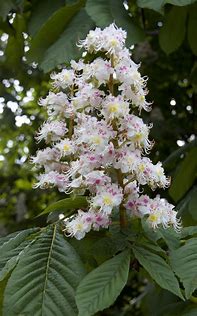 It became so fashionable that Capability Brown, the famous landscape architect, planted 4,800 on one estate in Wiltshire alone.
It became so fashionable that Capability Brown, the famous landscape architect, planted 4,800 on one estate in Wiltshire alone.
In late summer many horse chestnut trees are seen with brown foliage. This is caused by the horse chestnut leaf miner moth, whose larvae feed inside the leaves. There is no evidence to suggest that this harms the tree but it does affect its appearance considerably.
A horse chestnut tree could be seen by Anne Frank from the garret in Amsterdam, where she and her family hid from the Nazis. Her diary describes the joy she experienced looking at the “bare chestnut tree, on whose branches little raindrops shine, appearing like silver”. The tree blew down in 2010 but not before 11 saplings had been germinated from the tree and distributed across the world, including one in Batsford Arboretum near Moreton in Marsh.
Bird Cherry - Prunus padus
One of two native cherry trees, Bird Cherry mainly occurs in Scotland, Northern England, East Anglia and parts of Wales – rarely seen in Southern England. Found in wet woodland, hedgerows and river/stream banks, preferring base-rich soils.
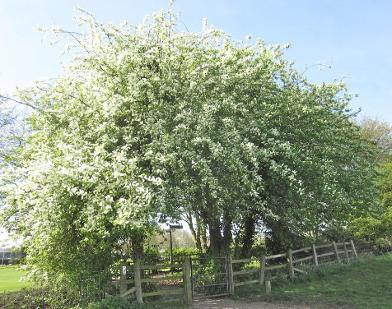 The bark is smooth (without the ‘rings’ associated with Wild Cherry), greyish brown, peeling and emits a strong acrid smell – said to ward off the plague if placed on the front door. The twigs are a deeper brown. Its leaves are dark green, oval, with fine sharply serrated edges and pointed tips each leaf having 2 glands at their base which produce a form of nectar to attract beneficial insects such as ants; younger leaves have hairs in the leaf axils.
The bark is smooth (without the ‘rings’ associated with Wild Cherry), greyish brown, peeling and emits a strong acrid smell – said to ward off the plague if placed on the front door. The twigs are a deeper brown. Its leaves are dark green, oval, with fine sharply serrated edges and pointed tips each leaf having 2 glands at their base which produce a form of nectar to attract beneficial insects such as ants; younger leaves have hairs in the leaf axils.
Bird Cherry flowers can be seen in April. They are white, five-petalled in clusters on short stalks (Racemes) and they are hermaphrodite (male and female parts within same flower). Strongly scented. The fruit, known as drupes, are reddish-black and have a bitter or astringent taste – which doesn’t put off many birds especially members of the Thrush family.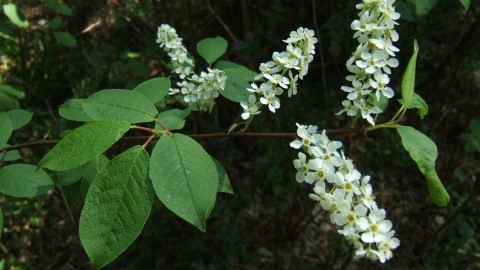 Many species of moth caterpillars will eat the leaves such as Bird Cherry Ermine (who can eat a single tree leafless) and Brimstone, also damage from the Cherry Blackfly can cause dieback.
Many species of moth caterpillars will eat the leaves such as Bird Cherry Ermine (who can eat a single tree leafless) and Brimstone, also damage from the Cherry Blackfly can cause dieback.
The tree has had many uses including using the fruits for dying wool, similarly the bark once used to colour fishing nets. The wood has been used to make small objects such as tool handles and the chemicals from the bark as a pesticide (before industrial pesticides came in). Medicinally cough mixture was produced, from the fruits, and eyewash for conjunctivitis.
Wollemi Pine - Wollemi Nobilis
A Wollemi can be found in the Arboretum at the top of the main path, on the right. This tree was thought to be extinct but a small number were discovered in 1994, growing within the Wollemi National Park (hence its name), situated in the Blue Mountains, New South Wales, Australia. Due to the small number of trees which remain in the wild their exact location is kept secret and the tree is classified as a critically endangered species. During the 2019/2020 Australian bush fire season, the 100 or so trees had to be saved by specialist fire fighters. However, it can be successfully cloned and following a mass propagation campaign is now found growing all around the world.
It belongs to an ancient family of coniferous trees and can grow up to 130 feet. The leaves are flat lined and arranged spirally on the shoot. The bark is dark brown and knobbly. It has green cones, which are both male and female and it is believed the oldest tree can live to 1000 years.
Despite concerns, it might not grow in the UK, it can survive in a temperature range of minus12C and plus 45C.
Giant Redwood - Sequoiadendron giganteum
The Giant Redwoods are claimed to be the most massive trees on earth. They originate from California and were discovered there in 1852. The seeds of the Giant Redwood were collected by William Lobb, who was an English plant hunter, and brought back to the UK in 1853. The oldest known Giant Redwood is 3200 years old. The tree is sometimes known as Wellingtonia after the Duke of Wellington as it was discovered in the year that he died. In the UK Giant Redwoods have grown up to 53 metres in height and a trunk diameter of 4 metres. They are evergreen with cones that ripen in their second year.
There are four Giant Redwoods in the Arboretum and two in the Park near the chapel. They are the largest trees on this site but are probably only 150 years old at the most.
The thick spongey bark is fire resistant as it contains no resin. The tree is regenerated by seed and the seeds can be released from the dried cone when a fire has passed by the tree. The wood is purplish or red-brown in colour. The wood from mature trees is decay resistant but is fibrous and brittle and therefore has little commercial value. Due to their weight and brittleness the trees would often shatter when they hit the ground.
Scots Pine - Pinus Sylvestris
The Scots Pine is the only native pine in Britain. It is found on heathlands in the south of England but is widespread in Scotland and has been popular as a Christmas tree. 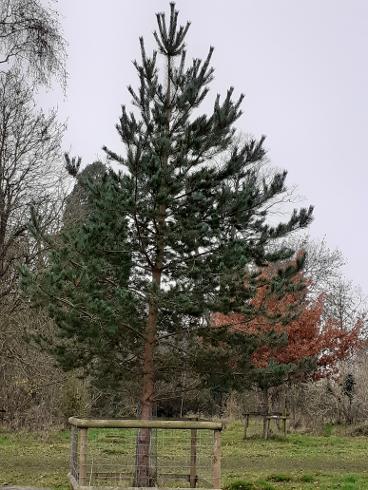 It grows on a wide range of soils but prefers light and dry sands and gravels. It is wind resistant and tolerates coastal conditions. The pyramid shape of the young tree changes as it matures to form a flatter spreading crown, reaching 36 metres. It has an expected lifespan of 150 to 300 years. Scots Pine wood is strong yet reasonably soft making it suitable for making furniture, doors and floors as well as telegraph poles. It was used to make charcoal and as a major source of turpentine, resin and tar in the past.
It grows on a wide range of soils but prefers light and dry sands and gravels. It is wind resistant and tolerates coastal conditions. The pyramid shape of the young tree changes as it matures to form a flatter spreading crown, reaching 36 metres. It has an expected lifespan of 150 to 300 years. Scots Pine wood is strong yet reasonably soft making it suitable for making furniture, doors and floors as well as telegraph poles. It was used to make charcoal and as a major source of turpentine, resin and tar in the past.
The tree has excellent wildlife value, with 172 invertebrate species, including the pine hawkmoth, feeding on it. In Scotland it provides nesting sites for ospreys and Scottish crossbills and the cones provide food for red squirrels. This particular tree in the Arboretumwas planted in 2010 but there are several more mature Scots Pines in the park – see the Tree Trail leaflet on our website.
Blue Atlas Cedar - Cedrus Atlantica Glauca
A member of the Pine family of trees, originating from mountainous regions of the Mediterranean. Its range is now mainly focussed in the Atlas Mountains of Morocco as well as some in Algiers. Introduced to the UK in the 1840s as an ornamental tree.
There is a Blue Atlas Cedar in the Park. It has short silvery blue/bluish-green needles with translucent tips, these grow in large clusters or whorls of 20-40 needles. Male cones are produced on the lower branches to approx. 5cm long, they are more slender than the female cones. The latter form on the upper branches maturing into a characteristic barrel-shape, often with a dimpled top, starting green and turning brown - taking up to two years to grow.
A slow growing tree (very similar to Lebanon Cedar) that can reach 30+ metres, tolerant of hot and dry conditions. The tree produces aromatic oil that is a natural insect repellent and is often used in making furniture drawers.
The natural forests of Morocco in the Atlas Mountains provide habitat for the endangered Barbary Macaque, however, the extent of these forests is much reduced these days.
Dawn Redwood - Metasequoia Glyptostroboides
The Dawn Redwood, one of three types of Redwood, was until the mid 1940s, known only from fossilised remains. Then in the Hubei province of China around 100 were found to be growing. Seeds were collected and sent to Europe and North America to be grown on. The first seeds were planted in Britain in 1948.
Dawn Redwoods are known to grow to 50m, (165 feet ) and are a fast growing conical shaped deciduous tree. The leaves are 1-3 cms long and bright green, turning an orangery brown before falling. Its bark is reddish brown, vertically fissured and tends to exfoliate in ribbon like strips. The buds, uniquely, are on the underside of the twigs rather than above.
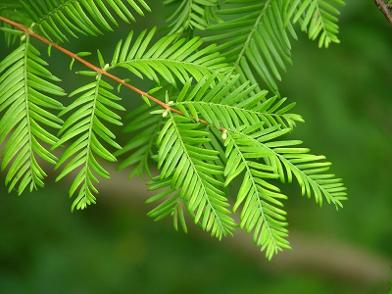 We have two growing in the arboretum and one in the park and we know one was planted in June 1953 to commemorate the coronation of our Queen Elizabeth. Only some 3 million years after the last one may have grown here!!
We have two growing in the arboretum and one in the park and we know one was planted in June 1953 to commemorate the coronation of our Queen Elizabeth. Only some 3 million years after the last one may have grown here!!
In the wild the Dawn Redwood is classified as an endangered species by the I.U.C.N (International Union for Conservation of Nature ) so all the more reason for us to protect it.
Medlar - Mespilus Germanica
There is one medlar tree in the Arboretum. It is situated on the corner of the path between the weir and the wildlife pond. 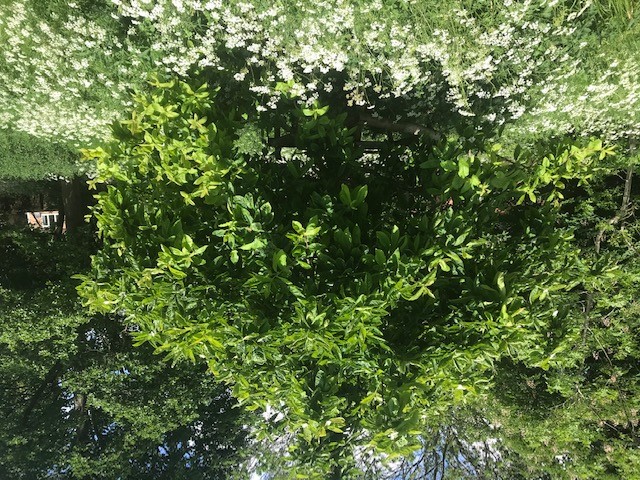 The medlar tree may have been cultivated for as long as 3000 years. The medlar was an important fruit plant in Britain during Roman and mediaeval times before being superseded by other fruits but it remained popular until Victorian times when it went out of favour. It is indigenous to Iran, SW Asia and the Black Sea coasts of Bulgaria & Turkey.
The medlar tree may have been cultivated for as long as 3000 years. The medlar was an important fruit plant in Britain during Roman and mediaeval times before being superseded by other fruits but it remained popular until Victorian times when it went out of favour. It is indigenous to Iran, SW Asia and the Black Sea coasts of Bulgaria & Turkey.
Medlar trees are deciduous and can grow up to 26 feet but are generally shorter and more shrub like, living for between 30 and 50 years. 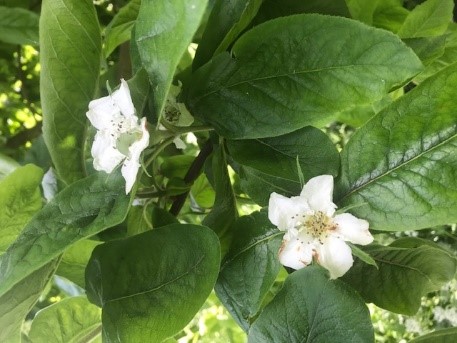 White flowers appear in late Spring and these are self-fertile, pollinated by bees. The reddish-brown fruit is a ‘pome’, another example being the apple and appears in late summer. It is distinguished by very wide spreading sepals.
White flowers appear in late Spring and these are self-fertile, pollinated by bees. The reddish-brown fruit is a ‘pome’, another example being the apple and appears in late summer. It is distinguished by very wide spreading sepals.
The fruits are hard and acidic before undergoing a process called ‘bletting’ during which the fruits soften. Bletting happens through frost or storage of the fruits. The skin wrinkles and becomes dark brown whilst the flesh turns from white to brown and is soft, like apple sauce. 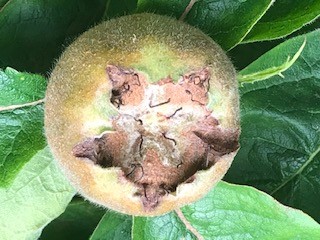 The fruit appears rotten but in fact is edible at this point. It can be eaten raw or turned into a sweet jelly known as medlar jelly and used as an accompaniment to cheese or cold meats.
The fruit appears rotten but in fact is edible at this point. It can be eaten raw or turned into a sweet jelly known as medlar jelly and used as an accompaniment to cheese or cold meats.
A quote from 1908 from the classical scholar F. M. Cornford, “Time is like the medlar fruit, it has the trick of going rotten before it is ripe”
Hawthorn - Crataegus
The Hawthorn is a small tree, some varieties of which will grow up to 15 metres. There are two types of Hawthorn that are native in the UK – crataegus monogyna and crataegus laevigata (Midland Hawthorn). They often hybridise with each other and are difficult to tell apart. 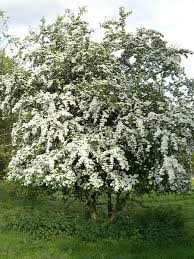 Hawthorns are native throughout Europe and are a slow growing hardy tree that withstands exposure to cold winds and low temperatures. They are used as hedging plants and were used for field boundaries in the eighteenth and nineteenth centuries. The Hawthorn is also known as May as this refers to the month in which it flowers. We have a number of Hawthorns in the arboretum that self-seed freely.
Hawthorns are native throughout Europe and are a slow growing hardy tree that withstands exposure to cold winds and low temperatures. They are used as hedging plants and were used for field boundaries in the eighteenth and nineteenth centuries. The Hawthorn is also known as May as this refers to the month in which it flowers. We have a number of Hawthorns in the arboretum that self-seed freely.
Hawthorn is a really useful tree for wildlife and can support more than 300 species of insect. 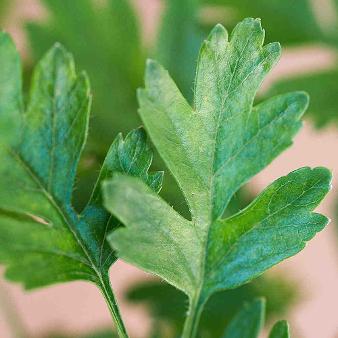 The flowers are a food source for nectar feeding insects. The leaves are a food source for many butterflies and moths. The berries are eaten by birds and mammals especially in winter. The dense, thorny foliage makes fantastic nesting shelter for many species of bird.
The flowers are a food source for nectar feeding insects. The leaves are a food source for many butterflies and moths. The berries are eaten by birds and mammals especially in winter. The dense, thorny foliage makes fantastic nesting shelter for many species of bird.
The berries, leaves and flower buds can also be consumed by humans. The berries are usually made into a type of jelly. The Hawthorn has been used in traditional medicine.
Indian Bean tree - Catalpa bignonioides
This particular tree is a golden form of Indian Bean tree - Catalpa Bignonioides "Aurea". There is an older, much larger Indian Bean tree next to this one in the Arboretum. Also known as Cigar Tree/Southern Catalpa. Originally from South East USA, brought over to Britain in the early 1700’s. Known by indigenous tribes as Kutuhlpa – meaning ‘winged head’. Bignonioides is named after French abbot John Paul Bignon.
A magnificent deciduous tree with its large pale green heart shaped leaves (20-30cm in length), with cordate base, that usually appear late, in April; interestingly the leaves secrete nectar from glands in the axils of the primary veins. The bark is pale brown turning into plates and ridges as matures. Its white flowers are trumpet shaped, grow in panicles and appear in June/July. They are spotted purple with yellow or gold spots/blotches – the purple markings act as nectaries luring in pollinating insects.
In September/October the conspicuous thin green seed pods or ‘beans’ appear which eventually turn brown, and these are what give the tree its vernacular name. Very much an ornamental tree of parks and gardens, receiving the RHS award of Golden Merit it is good to grow from seeds and cuttings.
The wood has been used for making fence posts and rails. Amongst Its medicinal uses it is said to act as a sedative (from the pods), treatment of whooping cough and asthma in children, and the leaves can be usedas a poultice on wounds.
Research in America has shown that the leaves produce extra nectar when eaten by caterpillars so as to attract species of ants to act as a defence mechanism.
Common Lime - Tilia Europaea
The Common Lime is the tallest broadleaved tree in Britain. It is a hybrid between the large leaved and small leaved limes, both of which are native to Britain, can reach 50 metres in height and live up to 500 years. (Lime trees are not related in any way to the citrus fruit of the same name.) 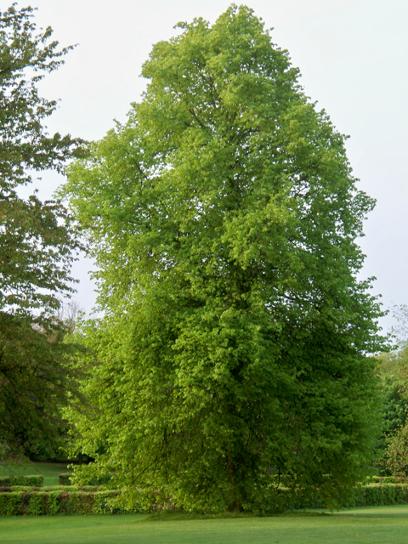 The lime trees in Barnwood Park and Arboretum are all Common Limes. Common Limes can be distinguished from other limes by the long shoots that sprout around the base of the tree. Small, sweet smelling, greenish-yellow flowers appear in July, providing abundant pollen and nectar for bees and many other insects. The leaves are food for many moths, including the Lime Hawk Moth.
The lime trees in Barnwood Park and Arboretum are all Common Limes. Common Limes can be distinguished from other limes by the long shoots that sprout around the base of the tree. Small, sweet smelling, greenish-yellow flowers appear in July, providing abundant pollen and nectar for bees and many other insects. The leaves are food for many moths, including the Lime Hawk Moth.
The trees often become infested with aphids, attracting their predators, including hoverflies, ladybirds and many species of bird. It is the aphids that are the source of the sticky, part digested leaf sap that drips from the trees in summer.
The stringy, inner bark of Common Lime was once used to make mats and ropes. Lime wood is light and fine grained and is used for wood carvings and making musical instruments.
Traditionally lime trees were pollarded to produce fodder and wood. Pollarding has been used in recent years to make the trees safer in public areas, by reducing their height and weight, and this tends to make the tree live longer.